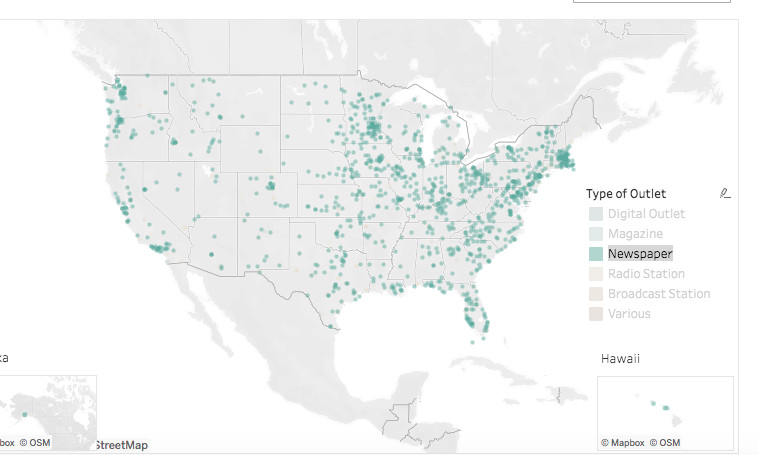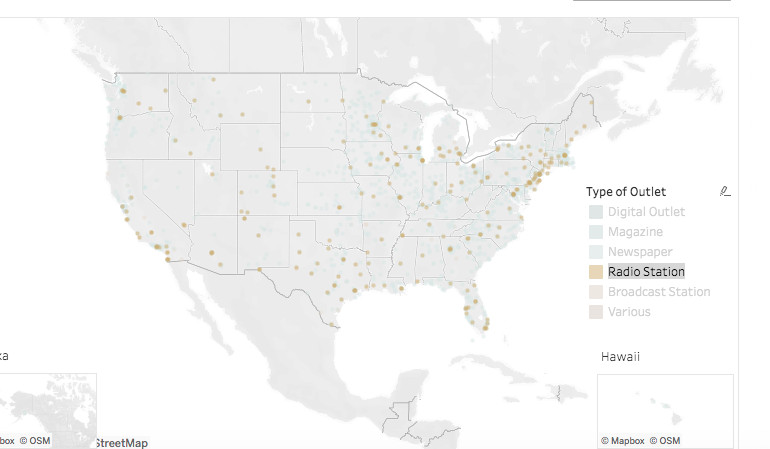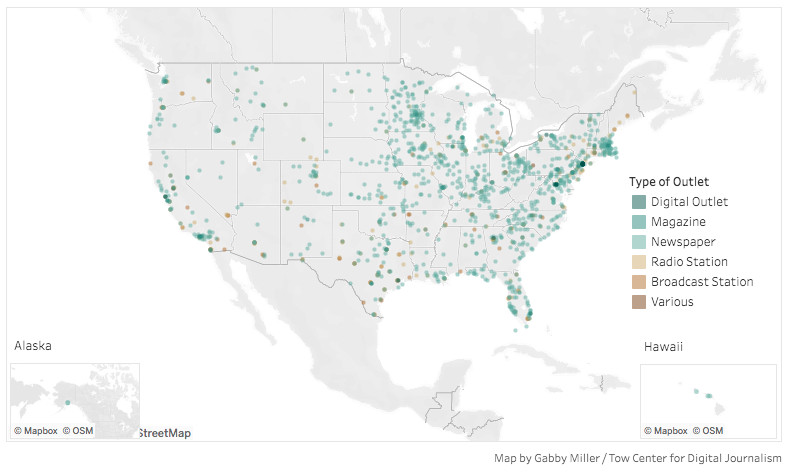Sign up for The Media Today, CJR’s daily newsletter.
In March of 2020, the Tow Center for Digital Journalism began tracking newsroom cutbacks in the wake of the pandemic. The tracker’s map tells part of the story of journalism’s ongoing crisis: an upheaval that hurt newsrooms, journalists, and—by straining journalism’s margins—the communities that those newsrooms and journalists are charged to serve.
One year later, here are five key takeaways:
- The journalism crisis of the past year has been a crisis across the board, for digital media, magazines, radio & TV stations, and—especially—newspapers.
Consider this graphic, which plots the location of newsrooms where newspapers have experienced cutbacks amid the COVID crisis, including both outlet-specific cuts and chainwide cutbacks understood to have affected all their properties:
 In October of last year, the Pew Research Center reported that newspapers were hard hit by the pandemic, experiencing a 42 percent loss in advertising revenue in the second quarter of 2020 (meanwhile, Fox News advertising revenue saw a 41 percent increase).
In October of last year, the Pew Research Center reported that newspapers were hard hit by the pandemic, experiencing a 42 percent loss in advertising revenue in the second quarter of 2020 (meanwhile, Fox News advertising revenue saw a 41 percent increase).
Broadcast and radio stations across the country also struggled. Pew reported a 24 percent loss in ad revenue for local television stations in the second quarter, though cable company re-transmission fees later made up the difference.
This map shows broadcast stations across the country that experienced cutbacks, including outlet-specific and chainwide cuts:
This one shows cutbacks at radio stations, including outlet-specific and chainwide cuts: Magazines and digital outlets also saw cutbacks, but the prevalence of newspapers across the country and the disequilibrium in their traditional business model meant that newspapers bore the brunt of the pandemic’s effect on journalism: borne out in layoffs, mergers, furloughs, pay cuts, print reductions, budget cuts, and closures.
Magazines and digital outlets also saw cutbacks, but the prevalence of newspapers across the country and the disequilibrium in their traditional business model meant that newspapers bore the brunt of the pandemic’s effect on journalism: borne out in layoffs, mergers, furloughs, pay cuts, print reductions, budget cuts, and closures.
- Significant layoffs happened across every medium.
There are no precise figures tallying the number of media layoffs, but the New York Times offered an “imperfect, but good estimate” that as many as 37,000 media workers may have experienced layoffs, furloughs, or lost pay amid the pandemic.
This map plots the digital outlets, magazines, newspapers, radio stations, and broadcast stations where layoffs occurred, including both outlet-specific cuts and chainwide cutbacks understood to have affected all their properties:

- Print cutbacks accelerated the shift away from print.
The cutback tracker reported changes to print at more than one hundred and sixty outlets. Though some publications have worked hard to bring back print editions (and some print publications have even launched mid-pandemic), I wrote in July that “as business models and consumer habits continue to change, journalism outlets wrestle to balance business interests, accessibility, and keeping up with a changing world—and choices made during a crisis will ripple into the future.”
- Cutbacks at Gannett loomed large.
Gannett—the largest newspaper chain in the country—implemented widespread furloughs in March, a round of layoffs in April, and another round of layoffs in June. In October, the company announced voluntary buyouts to all 21,000 of its employees; about 600 people opted in, Poynter reported, and Gannett accepted around 500 buyouts.
- More than sixty outlets have ceased publication.
Though some outlets found ways to resume publication after shutting down—and, in some cases, new publications set out to to fill news voids—the Tow Center reports the shuttering of sixty-six news outlets: fifty-six newspapers, three digital outlets, five magazines, and one radio station.
The Journalism Crisis Project aims to train our focus on the present crisis, tallying lost jobs and outlets and fostering a conversation about what comes next. We hope you’ll join us (click to subscribe).
EXPLORE THE TOW CENTER’S COVID-19 CUTBACK TRACKER.
CONTRIBUTE TO OUR DATABASE: If you’re aware of a newsroom experiencing layoffs, cutbacks, furloughs, print reductions, or any fundamental change as a result of covid-19, let us know by submitting information here. (Personal information will be kept secure by the Tow Center and will not be shared.)
Below, more on recent media trends and changes in newsrooms across the world:
- DOCUMENTING THE ESSENTIAL WORK OF LOCAL JOURNALISTS: This week, Poynter launched an oral history project documenting the experiences of twenty-eight local newsrooms across mid-America during the pandemic. “The idea was to capture history as it was happening and to grab memories while they were fresh of journalists surviving a pandemic of global proportions for the first time in a century,” William Mari, one of the project’s co-founders, told Kristen Hare. This oral history marks the official launch of Poynter’s Recovering the News project, which will consider a path forward for reviving local newsrooms after a decade of loss.
- IN SUPPORT OF COLLECTIVE BARGAINING: Some publishers have indicated support for federal legislation that would allow them to negotiate collectively with Google and other tech platforms, and though Google’s VP of news told Digiday that many news publishers prefer bilateral agreements, leaders at Gannett USAToday Network and California Times Group disagreed. Maribel Wadsworth, from Gannett USAToday, called the possibility of collective bargaining “an important start.” Reuters reported that in the next few weeks, bipartisan members of Congress are expected to introduce legislation that would make it easier for small publishers to negotiate with tech platforms.
- MERGING PUBLIC MEDIA WITH DIGITAL: An eighteen-month Harvard project studying the merging of public media with digital news startups found that public media could help address market failures in local newsrooms, but not without some reimagination, NiemanLab reported. The study found that the best examples of cultural transformation required personnel changes, time, commitment to a mission, and “grappling with the deep-seated cultural biases and inequitable practices of public media,” Elizabeth Hansen, a Tow Fellow, writes. The researchers also published a Public Media Mergers Playbook for organizations considering a public media and digital merger.
- HOW SOME ALT-WEEKLIES WEATHERED THE STORM: For the Daily Beast, Sophia June explored how four alt-weeklies survived the last year. The Cleveland Scene took a PPP loan and solicited reader support. Seven Days, in Vermont, still sells classified ads; when the pandemic hit, they reached out to new advertisers and received some outsize support from advertisers who wanted to support their mission. The Stranger, in Seattle, also asked for reader support and moved their revenue-generating amateur porn film festival online. The Austin Chronicle put together and sold a city coloring book, along with receiving a PPP loan. “After we moved on from the doom-and-gloom headlines, many papers continued to do backbreaking work, holding power structures accountable as they continued to cover the pandemic with shrunken newsrooms, supporting creative communities, and holding power structures accountable in the voicey, fearless way that only alt-weeklies can,” June writes.
- EBONY RESUMES PUBLICATION: Ebony, a magazine that spotlighted Black America for seventy-five years, re-launched this Monday after closing in 2019. “Ebony will relaunch with a startup mentality, a lean operation and lofty aspirations,”the Chicago Tribune reported. “The storied publication’s print format and its Chicago roots will be relegated to the past.” The Atlanta Journal-Constitution reported that Ebony and Jet—which plans to relaunch in June—will both have a major presence in Atlanta. “For over 75 years we have committed ourselves to the authentic illumination of Black lives,” the publication tweeted on Monday. “As we are rebirthed, we will be BOLD in pursuit of telling OUR stories by way of OUR voices.”
- “ZOMBIE” SUBSCRIBERS DON’T ENGAGE: Nearly half of local news subscribers only visit the online publication less than once a month, Northwestern University’s Medill Local News Initiative found. Such low-engagement subscribers are known by many in the industry as “zombies,” Poynter reports. “Even though the living dead may still pay for local news, they seem like a weak foundation to build a future on,” Mark Jacob writes. (Elsewhere, Better/News explains how the Arizona Republic improved its relationship with “zombie” subscribers).
- CANADIAN MEDIA COMPANY PLANS TO LAUNCH ONLINE CASINO: Torstar Corp., the company that owns the Toronto Star and other local Canada papers, announced plans to launch an online Ontario casino to help fund their journalism, the CBC reported. In May of 2020, Torstar Corp. was purchased by an investment company called Nordstar. Under current rules, only the Ontario government is authorized to conduct online gambling, but the rules are set to change, and Torstar Corp.’s new owners plan to take advantage of the change. (Elsewhere, Axios reported that casinos are investing millions of dollars in sports media.)
- SHUTTERED UK MAGAZINE LAUNCHES A SUBSTACK: The former editors of Q Magazine, a music monthly in the UK that ceased publication in July of 2020 due to fallout from the pandemic, have launched a Substack newsletter called The New Cue, The Guardian reported last week. The newsletter will publish a few editions for free, then offer monthly and yearly subscriptions.
- INSIDER RAISES SALARY MINIMUM: Insider Inc., formerly known as Business Insider, has announced that its full-time US employees will make a minimum salary of $60,000, Axios reported. Employees currently receiving bonuses will instead receive a salary that incorporates their projected bonus, and some employees will see salary increases in light of the new minimum.
- FUNDRAISING, ONE ASK AT A TIME: In British Columbia, nonprofit magazine The Narwhal uses “mini-campaigns” to fundraise when it has specific needs, the Indie Publisher newsletter reported. “You’re basically looking for moments in time when you have a compelling reason to ask people to support your work,” Emma Gilchrist, The Narwhal’s editor-in-chief, told Lauren Kaljur.
- POYNTER ADVISES NEW FREELANCERS ON TAXES: After a year filled with journalism layoffs, Poynter has released a tax guide for freelancers who began freelancing for the first time in 2020. Freelancers should keep track of receipts, Poynter advises, and remember to pay quarterly taxes. The rest of the tax advice is here.
- AMERICAN-STATESMAN VOTES “YES” FOR A UNION: Austin American-Statesman journalists voted thirty-six to twelve in favor of unionization, the publication reported last week. Elsewhere, at Medium, a union effort stalled after falling just short of majority support in a vote last Friday, The Verge reported.
- GANNETT SELLS LOCAL PAPER: A local businessman and former elected official has purchased the Pacific Daily News, a Gannett-owned newspaper in Guam, returning the paper to local ownership.
JOURNALISM JOBS AND OPPORTUNITIES: MediaGazer has been maintaining a list of media companies that are currently hiring. You can find it here. The Deez Links newsletter, in partnership with Study Hall, offers media classifieds for both job seekers and job providers. The Successful Pitches database offers resources for freelancers. The International Journalists Network lists international job opportunities alongside opportunities for funding and further education.
Has America ever needed a media defender more than now? Help us by joining CJR today.



